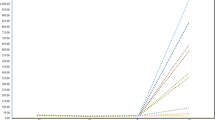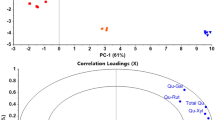Abstract
Eggplant fruit are a rich source of phenolic acids that influence fruit culinary quality and antioxidant content. We evaluated the influence of production environments and stability of diverse genotypes across environments for eggplant fruit phenolic acid content. Ten Solanum melongena accessions consisting of five F1 hybrid cultivars, three open-pollinated cultivars and two land race accessions, plus one S. macrocarpon and one S. aethiopicum accession, were grown at two locations under greenhouse and open field environments. Twenty phenolic acid conjugates were identified in fruit flesh and assigned to six classes that included hydroxycinnamic acid amides, caffeoylquinic acid esters, hydroxycinnamoylquinic acid esters, malonylcaffeoylquinic acid esters, di-hydroxycinnamoylquinic acid esters, and other hydroxycinnamic acid conjugates. There were significant differences among accessions for total phenolic acid conjugate content and for all six classes. There were no significant differences detected among the environments for any of the variables. However, the environment × accession interaction was highly significant for all phenolic acid classes. Broad-sense heritability estimates for all six phenolic acid classes were high, ranging from 0.64 to 0.96. Stability analysis demonstrated widespread instability for phenolic acid content across environments. Stability of the predominant caffeoylquinic acid esters class positively influenced stability of total phenolic acid content for some but not all genotypes. High heritability, coupled with highly significant genotype × environment interactions suggests that stability estimates may improve the efficiency of breeding new genotypes with predictable performance across environments.
Similar content being viewed by others
References
Allard RW, Bradshaw AD (1964) Implications of genotype–environment interactions in applied plant breeding. Crop Sci 4:503–507
Baixauli C (2001) Berenjena. In: Nuez F, Liacer G (eds) La horticultura española. Ediciones de Horticultura, Reus, pp 104–108
Bravo L (1998) Polyphenols: chemistry, dietary sources, metabolism, and nutritional significance. Nutr Rev 56:317–333
Dixon RA, Pavia NL (1995) Stress-induced phenylpropanoid metabolism. Plant Cell 7:1085–1097
Dogan M, Arslan O, Dogan S (2002) Substrate specificity, heat inactivation and inhibition of polyphenol oxidase from different aubergine cultivars. Int J Food Sci Technol 37:415–423
Dos Santos MD, Almeida MC, Lopes NP, de Souza GE (2006) Evaluation of the anti-inflammatory, analgesic and anti-pyretic activities of the natural polyphenol chlorogenic acid. Biol Pharm Bull 29:2236–2240
Fernandez GCJ (1991) Analysis of genotype × environment interaction by stability estimates. HortScience 26:947–950
García-Salas P, Gómez-Caravaca AM, Morales-Soto A, Segura-Carretero A, Fernández-Gutiérrez A (2014) Identification and quantification of phenolic compounds in diverse cultivars of eggplant grown in different seasons by high-performance liquid chromatography coupled to diode array detector and electrospray-quadrupole-time of flight-mass spectrometry. Food Res Int 57:114–122
Hanson PM, Yang RY, Tsou SCS, Ledesma K, Engle L, Lee TC (2006) Diversity in eggplant (Solanum melongena) for superoxide scavenging activity, total phenolics, and ascorbic acid. J Food Compos Anal 19:594–600
Kang MS (1989) A new SAS program for calculating stability variance parameters. J Hered 80:415
Klein RM (1990) Failure of supplementary ultraviolet radiation to enhance flower color under greenhouse conditions. HortScience 25:307–308
Knapp SJ, Stroup WW, Ross WM (1985) Exact confidence intervals for heritability on a progeny mean basis. Crop Sci 25:192–194
Luthria D, Singh AP, Wilson T, Vorsa N, Banuelos GS, Vinyard BT (2010) Influence of conventional and organic agricultural practices on the phenolic content in eggplant pulp: plant to plant variation. Food Chem 121:406–411
Ma C, Whitaker BD, Kennelly EJ (2010) New 5-O-caffeoylquinic acid derivatives in fruit of wild eggplant relative S. viarum. J Agric Food Chem 58:9645–9651
Manach C, Scalbert A, Morand C, Remesy C, Jimenez L (2004) Polyphenols: food sources and bioavailability. Am J Clin Nutr 79:727–747
Mennella G, Scalzo R, Fibiani M, D’Alessandro A, Francese G, Toppino L, Acciarri N, Almeida AE, Rotino GL (2012) Chemical and bioactive quality traits during fruit ripening in eggplant (S. melongena L.) and allied species. J Agric Food Chem 60:11821–11831
Meyer RS, Karol KG, Little DP, Nee MH, Litt A (2012) Phylogeographic relationships among Asian eggplants and new perspectives on eggplant domestication. Mol Phylogenet Evol 63:685–701
Ong KW, Hsu A, Tan BK (2012) Chlorogenic acid stimulates glucose transport in skeletal muscle via AMPK activation: a contributor to the beneficial effects of coffee on diabetes. PLoS One 7:e32718
Payyavula RS, Duroy AN, Kuhl JC, Pantoha A, Pillai SS (2012) Differential effects of environment on potato phenylpropanoid and carotenoid expression. BMC Plant Biol 12:39
Plazas M, Prohens J, Cuñat AN, Vilanova S, Gramazio P, Herraiz FJ, Andújar I (2014) Reducing capacity, chlorogenic acid content and biological activity in a collection of scarlet (Solanum aethiopicum) and gboma (S. macrocarpon) eggplants. Int J Mol Sci 15:17221–17241
Prior RL (2003) Fruits and vegetables in the prevention of cellular oxidative damage. Am J Clin Nutr 78:570S–578S
Pritts M, Luby J (1990) Stability indices for horticultural crops. HortScience 25:740–745
Prohens J, Rodriguez-Burruezo A, Raigon MD, Nuez F (2007) Total phenolic acid concentration and browning susceptibility in a collection of different varietal types and hybrids of eggplant: implications for breeding for higher nutritional quality and reduced browning. J Am Soc Hortic Sci 132:638–646
Prohens J, Whitaker BD, Plazas M, Vilanova S, Hurtado M, Blasco M, Gramazio P, Stommel JR (2013) Genetic diversity in morphological characters and phenolic acids content resulting from an interspecific cross between eggplant, Solanum melongena, and its wild ancestor (S. incancum). Ann Appl Biol 162:242–257
Raigon MD, Prohens J, Munoz-Falcon JE, Nuez F (2008) Comparison of eggplant landraces and commercial varieties for fruit content of phenolics, minerals, dry matter and protein. J Food Compos Anal 21:370–376
Raigon MD, Rodriguez-Burruezo A, Prohens J (2010) Effects of organic and conventional cultivation methods on composition of eggplant fruits. Agric Food Chem 58:6833–6840
San Jose R, Sanchez-Mata MC, Camara M, Prohens J (2014) Eggplant fruit composition as affected by the cultivation environment and genetic constitution. J Sci Food Agric 94:2774–2784
Sato Y, Itagaki S, Kurokawa T, Ogur J, Kobayashi M, Hirano T, Sugawara M, Iseki K (2011) In vitro and in vivo antioxidant properties of chlorogenic acid and caffeic acid. Int J Pharm 403:136–138
Setimela PS, Vivek B, Banziger M, Crossa J, Maideni F (2007) Evaluation of early to medium maturing open pollinated maize varieties in SADC region using GGE biplot based on the SREG model. Field Crop Res 103:161–169
Shukla GK (1972) Some statistical aspects of partitioning genotype environment components of variability. Heredity 29:237–245
Stommel JR, Whitaker BD (2003) Phenolic acid content and composition of eggplant fruit in a germplasm core subset. J Am Soc Hortic Sci 128:704–710
Suzuki A, Yamamoto N, Jokura H, Yamamoto M, Fujii A, Tokimitsu I, Saito I (2006) Chlorogenic acid attenuates hypertension and improves endothelial function in spontaneously hypertensive rats. J Hypertens 24:1065–1073
University of Maryland (2007) Commercial vegetable production recommendations, University of Maryland Cooperative Extension Service Bulletin 236. College Park, MD
Whitaker BD, Stommel JR (2003) Distribution of hydroxycinnamic acid conjugates in fruit of commercial eggplant (Solanum melongena L.) cultivars. J Agric Food Chem 51:3448–3454
Winter M, Herrmann K (1986) Esters and glucosides of hydroxycinnamic acids in vegetables. J Agric Food Chem 34:616–620
Wu S, Meyer RS, Whitaker BD, Litt A, Kennelly EJ (2013) A New liquid chromatography-mass spectrometry-based strategy to integrate chemistry, morphology, and evolution of eggplant (Solanum) species. J Chromatogr A 1314:154–172
Yang JS, Liu CW, Ma YS, Weng SW, Tang NY, Wu SH, Ji BC, Ma CY, Ko YC, Funayama S, Kuo CL (2012) Chlorogenic acid induces apoptotic cell death in U937 leukemia cells through caspase- and mitochondria-dependent pathways. In Vivo 26:971–978
Acknowledgments
Mention of trade names or commercial products is solely for the purpose of providing specific information and does not imply recommendation or endorsement by the U.S. Department of Agriculture.
Conflict of interest
The authors declare that they have no conflict of interest.
Author information
Authors and Affiliations
Corresponding author
Rights and permissions
About this article
Cite this article
Stommel, J.R., Whitaker, B.D., Haynes, K.G. et al. Genotype × environment interactions in eggplant for fruit phenolic acid content. Euphytica 205, 823–836 (2015). https://doi.org/10.1007/s10681-015-1415-2
Received:
Accepted:
Published:
Issue Date:
DOI: https://doi.org/10.1007/s10681-015-1415-2




